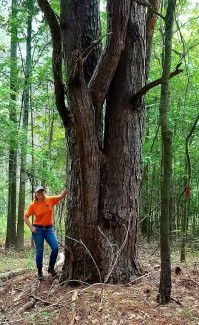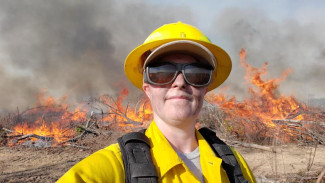
Meet Regine Skelton, County Forester for the Arkansas Department of Agriculture – Forestry Division, District #5 (agriculture.arkansas.gov). Regine was awarded the Arkansas Forestry Association’s 2020 Communicator of the Year Award. You can hear about Regine’s work her own words in this video.
What inspired you to become a forester?
I grew up in the sprawling metropolis of Dallas-Fort Worth, Texas, but my family would often flee the hustle and bustle of city life by escaping to family forestland in east Texas. I grew up running around the woods, and could gauge my father’s confidence and perception of my maturity based on the tools I received for these escapades, started with just picking up sticks and clearing blockages in streams, moved up to a hatchet, and then an axe. I knew I was an “adult” when I got my very own chainsaw.
In senior year of high school I decided it was really time to choose my career path. While I excelled in art, I knew I didn’t want to “draw what sells”, so I opted to keep that as a side hobby. I always enjoyed walking in the woods and soon learned it was an actual career. My father knew someone who was a forester, and I got to speak with him on the phone about the good and bad of the field. I applied to 6 colleges, and received a full ride offer to University of Arkansas in Monticello, but opted to turn that down for Stephen F Austin State University because, in contrast to UAM which focused on “growing trees like corn,” aka Timber Investment, SFA offered five different options for specialization. I opted to specialize in fire management; I figured that the job would likely be rather stable, and that it was unlikely that the impending robot takeover would tackle this field effectively due to the remote nature of the position.
Are you a landowner as well?
My family owns 140 acres of climax-stage mixed-pine hardwood in east Texas, with a 20-acre lake in the middle. I am set to inherit one half of it, my sister the other. Currently I own .4 acres for my home-site in Hot Springs, Arkansas.
How long have you been working with Arkansas landowners, and what geography do you cover with your work?
I started my position with the AR Forestry Division in December 2012 after my temporary job in Alaska for the USFS ended. I started my position covering the swampy low-lands of Grant (633 square miles) and Dallas (668 square miles) counties. In 2015, I took a lateral transfer and moved to covering Garland (735 square miles) and Clark (883 square miles) counties, which are the foothills of the Ouachita Mountains. I enjoy the increased terrain and greater variety of forest types of this area.
What are some common questions you get from women landowners?
The majority of the women landowners I work with are reaching out to me as the Urban Forestry Representative for the district (6 counties covering 4,271 square mi). These individuals are curious about the species, health, and hazards of their yard trees as well as how to help them grow well. I have a few women landowners who have sizeable properties that I work with, and I know most of them through my seat as a District Chair of the Arkansas Branch of the American Tree Farm System. They are usually inquiring about cost-share opportunities through the Farm Bill and NRCS programs, or how to conduct a timber sale.
What’s some advice you have for new (women) landowners?
Reach out to your state’s forestry service and inquire about the government programs (state and federal) that are available to your area. Engage with the extension service—they have a wealth of generalized information. My state provides free soil testing and plant health issue testing free of charge.
What you would like to see in the forests in your region, and what is your vision for landowner engagement?
I am enamoured with the increasing acceptance and participation of forest certification programs (such as USFS Forest Stewardship Program, American Tree Farm System, Forest Stewardship Council, etc) in the state.
I am excited to be assisting with the restoration efforts of the Ozark Chinquapin that was devastated by the chestnut blight. In fact, I received another award for this assistance on Halloween! Through this work, we look for resistant examples to breed, to create a resistant variety on chinquapin to restore the species.
I also love continuing to engage students through tree-planting ceremonies. I mostly help coordinate, figuring out what trees suit the soil, assisting with spacing, hole depth, and soil amendments, and guiding groundskeepers on the long-term care instructions for the new trees.





